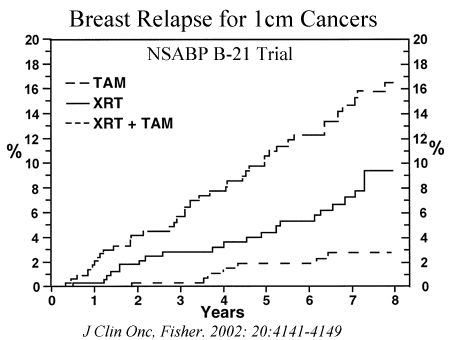After the NSABP B-06 trial it was clear that lumpectomy
alone was inadequate for most patients, but the question arose as to whether patients with
very small tumors (1cm or less) with lumpectomy and clear margins, could skip the
radiation and instead receive Tamoxifen. This led to the NSABP B-21
trial. They noted that those receiving Tamoxifen had a lower risk of developing
breast cancer in the opposite breast (0.6% versus 3.3%) but it did not eliminate the need
for radiation. Tamoxifen, Radiation
Therapy, or Both for Prevention of Ipsilateral Breast Tumor Recurrence After
Lumpectomy in Women With Invasive Breast Cancers of One Centimeter or Less (Journal
of Clinical Oncology, Vol 20, Issue 20 (October), 2002: 4141-4149)
This trial was prompted by uncertainty about
the need for breast irradiation after lumpectomy in node-negative
women with invasive breast cancers of
 1 cm, by speculation that tamoxifen (TAM) might be as or more
effective than radiation therapy (XRT) in reducing the rate of
ipsilateral breast tumor recurrence (IBTR) in such women, and
by the thesis that both modalities might be more effective than
either alone. After lumpectomy, 1,009 women were randomly
assigned to TAM (n = 336), XRT and placebo (n = 336), or XRT
and TAM (n = 337).
1 cm, by speculation that tamoxifen (TAM) might be as or more
effective than radiation therapy (XRT) in reducing the rate of
ipsilateral breast tumor recurrence (IBTR) in such women, and
by the thesis that both modalities might be more effective than
either alone. After lumpectomy, 1,009 women were randomly
assigned to TAM (n = 336), XRT and placebo (n = 336), or XRT
and TAM (n = 337).
RESULTS: XRT and placebo resulted in a 49%
lower hazard rate of IBTR than did TAM alone; XRT and TAM
resulted in a 63% lower rate than did XRT and placebo. When
compared with TAM alone, XRT plus TAM resulted in an 81%
reduction in hazard rate of IBTR.
Cumulative incidence of IBTR through
8 years was 16.5% with TAM, 9.3% with XRT and placebo, and 2.8%
with XRT and TAM. XRT reduced IBTR below the level
achieved with TAM alone, regardless of estrogen receptor (ER)
status. Distant treatment failures were infrequent and not
significantly different among the groups. When TAM-treated women were
compared with those who received XRT and placebo, there was a
significant reduction in CBC (hazard ratio, 0.45; 95% confidence
interval, 0.21 to 0.95; P = .039). Survival in the three
groups was 93%, 94%, and 93%, respectively.

|


